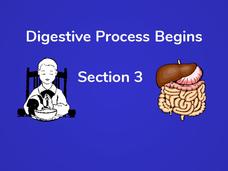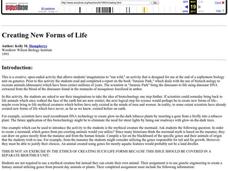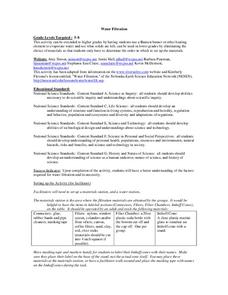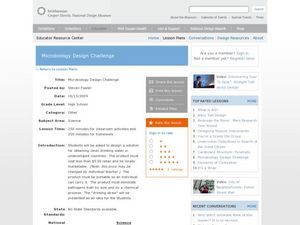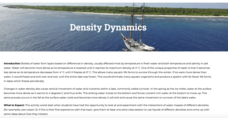Curated OER
Digestive Process Begins
Take your class on a journey through the digestive track with this resource. The physical and chemical processes of digestion are detailed, along with the names of various structures and substances involved, but the processes of the...
Curated OER
Fresh Foods from Farm to Table
Are you a good egg? Learners begin a farm-to-table lesson by acting out verbs in groups to demonstrate the egg production process, and then research the steps using online resources. Several excellent videos are linked through the...
Spectrum
Grade 5 Standardized Test Prep
Here you'll find a great sampling of practice standardized test questions organized into four sections: ELA, mathematics, social studies, and science. Help your learners become familiar with the types of multiple-choice questions...
Baylor College
How Much Water Do Humans Need?
Physical or life science learners measure the amounts of water eliminated by intestines and the urinary system, and the amounts lost via respiration and perspiration. In doing so, they discover that the body's water must be replenished...
Baylor College
Healthy Homes
Meant to follow a lesson about how concentrated air particles can be inside of a building, this resource gets individuals to assess the possible air pollutants in their own homes. They take home a worksheet and circle spots on it that...
Baylor College
Water in Your Body
Do you know how much water you have had in the last 24 hours? Do you know how much your body needs? For this hands-on activity, your class members will estimate how much water our bodies lose each day by filling and emptying one-liter...
Curated OER
Creating New Forms of Life
Although not particularly educational, here is a creative group activity in which high school biologists will use their imaginations to create a new life form combining characteristics from existing life forms. Each group must come up...
Curated OER
Mosquito Life Cycles
Learners gather mosquito eggs to record the mosquito life cycle using drawings, descriptions, and any other appropriate means. In small groups, they analyze and describe the process of complete metamorphosis. They classify mosquitoes...
Curated OER
Water Filtration
Students investigate our water system and how it is filtered. In this science lesson, students perform a laboratory activity to investigate the process that goes into filtering water. They relate this activity to other subject areas...
Curated OER
Autumn
Take a walk through the forest as the leaves change color and fall from the trees, making way for a new ecosystem cycle to cycle through. An inquiry-based lesson plan examines how the process of decomposition eliminates tons of...
Curated OER
Microbiology Design Challenge
Students discover dangers to human health by researching what's in our drinking water. In this water purification lesson, students discuss the conditions of water in undeveloped countries and why it is unsafe to drink....
Curated OER
Bacteria in Your Life
In this bacteria worksheet, students describe the process that kills harmful bacteria in milk. Then they describe what types of bacteria are helpful to farmers and which two plants have these bacteria in their roots. Students also name...
Curated OER
Life at Risk
Students examine the characteristics of the peregrine falcon. They investigate endangered and extinct species, and how the environment affects the process.
Curated OER
Respiratory System
Students analyze the function of the lungs. In this lesson about the Respiratory System, students explore breathing and the movement of air through the lungs. Students perform an 4 part experiment to observe what it might look like for...
Curated OER
Why Is Evolution Controversial?
Young scholars explore why evolution has always been a controversial topic. They use scientific process to determine patterns and to critically analyze alternative explanations for natural phenomena.
Curated OER
WHERE'S THE BEEF?
The student will become visually aware of the different shapes of wholesale cuts of beef.1. Ask a local meat cutter to make a class visit to explain his or her job. 2. Enlarge the steer outline on Student Worksheet B, and place it on a...
Curated OER
# 12 Using Bottled Water as a Problem Solving Exercise in Chemical Identification
Students work in groups of two or three, groups are given four unidentified bottled waters in unmarked containers and the chemical characteristics taken from the label on the bottled waters. They devise and carry out a plan to match the...
Consortium for Ocean Science Exploration and Engagement (COSEE)
Arctic Smorgasbord
Though the walrus spends roughly one third of its time on land, it eats organisms that live on the bottom of the ocean. The first in a series of five, the lesson uses a variety of plant and animal cards to have scholars build an arctic...
Curated OER
Solar Kit Lesson #7 - Positioning Solar Panels I: Explorations with Tracking
In this first part of a two-part lesson, learners track and record the sun's azimuth using a solar panel. They graph and analyze the data to identify relationships among the time of day, the altitude and azimuth of the sun, and the...
Serendip
Food Webs, Energy Flow, Carbon Cycle, and Trophic Pyramids
The reintroduction of a species to an area doesn't always go as expected. Scholars learn about the reintroduction of wolves into Yellowstone National Park with a video, reading, and discussion questions. They complete a hands-on activity...
Curated OER
TE Activity: Broken Bones
Learners examine the discipline of biomedical engineering or bioengineering. They complete worksheets by participating in reading background information and completing a hands on activity. They design a prototype of a cast to set a...
Cold Spring Harbor Laboratory
Development Balances Cell Growth and Death
Cells demonstrate a life cycle like other living things, but what if death was no longer part of the cycle? Learn about the important balance requiring death to continue functioning. An online interactive introduces a group of scientists...
Curated OER
Density Dynamics
Students set up working models demonstrating lake turnover and the formation of deep water masses in the oceans.
Curated OER
Let's Get it Together! Reading to Learn
Let’s learn about frogs! Young readers are led through “Freaky Frogs,” a non-fiction article. Teach learners how to edit an article so there are fewer details to sift through. After talking through the article, they learn the six steps...
